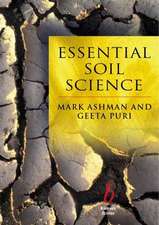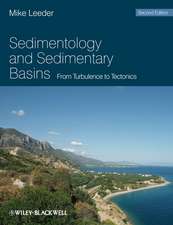Advances in Soil Science: Volume 9: Advances in Soil Science, cartea 9
Contribuţii de P. H. T. Beckett, J. Bouma, M. P. W. Farina, M.V. Fey, W.P. Miller, M.A. Pavan, I. Shainberg, M.E. Summer, K.G. Tilleren Limba Engleză Paperback – 21 sep 2011
Din seria Advances in Soil Science
-
 Preț: 444.08 lei
Preț: 444.08 lei -
 Preț: 448.67 lei
Preț: 448.67 lei - 25%
 Preț: 427.84 lei
Preț: 427.84 lei - 15%
 Preț: 467.93 lei
Preț: 467.93 lei - 18%
 Preț: 1954.45 lei
Preț: 1954.45 lei - 12%
 Preț: 312.43 lei
Preț: 312.43 lei -
 Preț: 374.21 lei
Preț: 374.21 lei - 25%
 Preț: 941.40 lei
Preț: 941.40 lei -
 Preț: 448.44 lei
Preț: 448.44 lei - 18%
 Preț: 1289.11 lei
Preț: 1289.11 lei - 15%
 Preț: 473.34 lei
Preț: 473.34 lei - 18%
 Preț: 1304.13 lei
Preț: 1304.13 lei - 22%
 Preț: 464.32 lei
Preț: 464.32 lei - 18%
 Preț: 1300.62 lei
Preț: 1300.62 lei - 18%
 Preț: 1941.67 lei
Preț: 1941.67 lei - 18%
 Preț: 1284.86 lei
Preț: 1284.86 lei - 15%
 Preț: 461.03 lei
Preț: 461.03 lei - 18%
 Preț: 1290.23 lei
Preț: 1290.23 lei - 18%
 Preț: 1119.62 lei
Preț: 1119.62 lei - 18%
 Preț: 1290.71 lei
Preț: 1290.71 lei - 18%
 Preț: 1233.70 lei
Preț: 1233.70 lei - 15%
 Preț: 641.38 lei
Preț: 641.38 lei - 15%
 Preț: 636.63 lei
Preț: 636.63 lei - 15%
 Preț: 643.84 lei
Preț: 643.84 lei - 15%
 Preț: 637.46 lei
Preț: 637.46 lei - 15%
 Preț: 701.59 lei
Preț: 701.59 lei - 15%
 Preț: 636.30 lei
Preț: 636.30 lei - 15%
 Preț: 639.59 lei
Preț: 639.59 lei - 15%
 Preț: 638.43 lei
Preț: 638.43 lei - 15%
 Preț: 648.89 lei
Preț: 648.89 lei - 15%
 Preț: 641.71 lei
Preț: 641.71 lei - 15%
 Preț: 637.59 lei
Preț: 637.59 lei -
 Preț: 385.47 lei
Preț: 385.47 lei - 15%
 Preț: 641.85 lei
Preț: 641.85 lei - 15%
 Preț: 637.28 lei
Preț: 637.28 lei - 15%
 Preț: 637.59 lei
Preț: 637.59 lei - 15%
 Preț: 638.57 lei
Preț: 638.57 lei - 15%
 Preț: 637.46 lei
Preț: 637.46 lei - 15%
 Preț: 637.93 lei
Preț: 637.93 lei -
 Preț: 384.70 lei
Preț: 384.70 lei - 28%
 Preț: 1414.85 lei
Preț: 1414.85 lei
Preț: 637.28 lei
Preț vechi: 749.73 lei
-15% Nou
Puncte Express: 956
Preț estimativ în valută:
121.96€ • 132.43$ • 102.44£
121.96€ • 132.43$ • 102.44£
Carte tipărită la comandă
Livrare economică 22 aprilie-06 mai
Preluare comenzi: 021 569.72.76
Specificații
ISBN-13: 9781461281443
ISBN-10: 146128144X
Pagini: 232
Ilustrații: IX, 219 p.
Dimensiuni: 155 x 235 x 12 mm
Greutate: 0.33 kg
Ediția:Softcover reprint of the original 1st ed. 1989
Editura: Springer
Colecția Springer
Seria Advances in Soil Science
Locul publicării:New York, NY, United States
ISBN-10: 146128144X
Pagini: 232
Ilustrații: IX, 219 p.
Dimensiuni: 155 x 235 x 12 mm
Greutate: 0.33 kg
Ediția:Softcover reprint of the original 1st ed. 1989
Editura: Springer
Colecția Springer
Seria Advances in Soil Science
Locul publicării:New York, NY, United States
Public țintă
ResearchCuprins
Use of Gypsum on Soils: A Review.- I. Introduction.- II. Use of Gypsum on Dispersive Soils.- III. Gypsum As an Ameliorant for Acid Subsoils.- IV. Environmental Concerns in Phosphogypsum Use.- V. General Conclusions.- References.- Heavy Metals in Soils and Their Environmental Significance.- I. Introduction.- II. Sources of Pollution.- III. Mobility of Metals in Soils and Landscapes.- IV. Ecological Consequences of Heavy Metal Pollution of Soils.- V. Prediction of the Impact of Heavy Metal Pollution of Soils.- VI. Guidelines for Regulatory Control of Pollution of Agricultural Land.- VII. Final Comment.- References.- The Use of Extractants in Studies on Trace Metals in Soils, Sewage Sludges, and Sludge-Treated Soils.- I. Introduction.- II. Forms of Combination of Trace Metals in Sewage Sludge, Sludged Soils, or Soils.- III. Survey of Extractants.- IV. Discussion.- References.- Using Soil Survey Data for Quantitative Land Evaluation.- I. Introduction.- II. Soil Survey Interpretation and Land Evaluation.- III. Modern Land Use Questions.- IV. Innovative Uses of Soil Survey Data.- V. Future Developments.- References.








